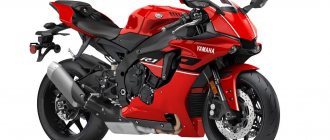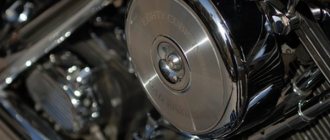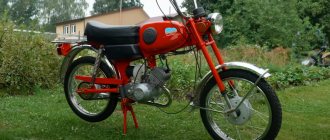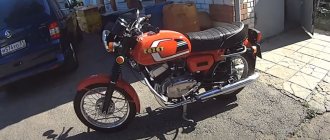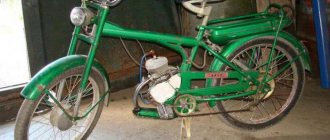Tourist on a moped
The types of two-wheeled small-capacity motor vehicles are quite diverse: these are bicycles with outboard motors, heavy mopeds that are more powerful and usually have gearboxes, mopeds - mopeds with a kickstarter, mini scooters (scooters).
All this equipment, in accordance with the Traffic Rules of the Russian Federation, can be combined under the general name “moped” - a two- or three-wheeled vehicle driven by an engine with a displacement of no more than 50 cubic meters. cm and having a maximum design speed of no more than 50 km/h. I note that in the 70s - 80s of the last century, in the USSR, the displacement of moped engines should not exceed 49.9 cubic meters. see, it was precisely this limit that Soviet factories were oriented towards. However, the difference between 49.9 cu. cm and 50 cc. cm is really not noticeable.
The first motorcycle, the production of which was launched at the beginning of the 20th century at the Leitner plant in Riga, can, to a large extent, be considered a moped. This motorcycle, called “ Russia ,” was an ordinary bicycle with a 1-cylinder internal combustion engine installed in the frame. The “Russia” motorcycle had in common an engine with a volume of more than 50 cc. cm, with mopeds - low maximum design speed (up to 40 km/h) and, most importantly, the presence of bicycle pedals.
The Rossiya motorcycle cost about 450 rubles, and only wealthy people could buy such a car. Therefore, production volumes were very small - a few dozen motorcycles per year. In 1910, the production of Rossiya motorcycles at the Leitner factory was discontinued, and the enterprise began to produce only bicycles.
Light mopeds
Prototypes of motorbikes were created in the USSR in the second half of the 30s. Thus, the Moscow Bicycle Plant produced a pilot batch of motorbikes with 1.3 liter outboard motors. pp., which were supplied from Odessa, from the Krasny Profintern plant. And in Leningrad, at the mechanical plant named after F. Engels, they mastered the production of outboard motors for the MD-1 men's bicycle.
In the photo there is an MVZ bicycle with a “Red Profintern” engine, 1936.
Photo from Moto magazine, March 2003.
Engine of the Leningrad Engels plant.
Photo from Moto magazine, March 2003.
However, the outbreak of the Great Patriotic War prevented the development of large-scale production of outboard motors and motorbikes. Mass production of this equipment began in the USSR only in the post-war period.
One of the first post-war suspended bicycle motors was the “ Irtysh ”, installed under the pedal carriage of a bicycle. The drive to the wheel was carried out by a rubber roller pressed against the tire. Engine with a displacement of 48 cubic meters. cm developed a power of 0.8 hp, which allowed the bike to accelerate to 30 km/h. “Irtysh” was produced in 1954-55 by the Omsk Engine Plant named after Baranov. Consumer reviews about the Irtysh were very mixed. Here, for example: “Our Irtysh brand motor... turned out to be a capricious and eccentric creature. It was hung so low that it almost dragged along the road. Road dirt dried between the ribs of its cylinder and filled the air filter... The clutch lever often broke. To get to the magneto, it was necessary to disassemble the entire bicycle carriage. The movement from the motor to the rear wheel was transmitted not through a chain, but through a rubber drum that rotated the wheel. But if it had recently rained and the road was wet, then the drum would only slide over the tire, and the bike would not move. We had to wait until the road dried out.” (D. Dar, A. Elyanov “There, around the bend...”, M., “Young Guard”, 1962).
The Irtysh prototype is a 1948 ILO-F48 engine.
Photo from Moto magazine, March 2003.
"Irtysh" on a bicycle.
Photo from Moto magazine, March 2003.
Around the same years as the Irtysh, a similar design but more powerful MD-65 (66 cc, 1.7 hp) was produced. The drive to the wheel was also carried out using a rubber drum.
D-4 engines in 1956 by the Kharkov Bicycle Plant . Unlike the Irtysh, which had a German prototype - the ILO F48 engine of the 1951 model, the D-4 was a completely domestic development. This is a two-stroke single-cylinder engine with spool valve timing, cylinder displacement 45 cc. cm, compression ratio - about 5.2. The engine developed a power of about 1 hp. at 4000 - 4500 rpm and had a chain drive to the rear wheel. Bicycles with D-4 installed on them reached speeds of up to 40 km/h.
It is curious that this engine was created by a self-taught rural designer (!) Philip Aleksandrovich Pribyloy, spending about 10 years on the work. Compared to the “Irtysh” and similar domestic and foreign designs, the D-4 looked so advantageous that, for example, the magazine “Technology for Youth” called it the best bicycle engine in the world (K. Pigulevsky, First place in the competition with the best engines in the world , “Technology for Youth”, No. 2, 1958).
It is difficult to say whether anyone in those years tested the D-4 in comparison with the “best engines in the world,” but the D-4, indeed, was a new word in the production of bicycle engines. It is no coincidence that, having repeatedly undergone modernizations, under the names: D-4, D-5, D-6, D-8, it was produced in our country for about 40 years - first at the Kharkov Bicycle Plant, then at the Leningrad “Red October”. Production was truly massive: in 1982, the 8 millionth “D” series engine was produced. A modernized “dashka” is still being produced, although not here, but in China. Moreover, the Chinese version of Pribyly’s creation is successfully exported to Western Europe, the USA, and to us, Russia.
In 1958, the Kharkov bicycle factory began producing the B-901 .
Compared to a regular road machine, this bike had a shock absorber in the front fork and larger tires. Apparently, the B-901 can be considered the first Soviet mass-produced motorbike. Then the production of motorbikes was transferred to the Lvov Metal Plant (since 1960, Lviv Motorcycle Plant - LMZ). In the same year, the plant began producing B-902 , which differ from the B-901 mainly in the frame design.
Photo from the site: alkatrion.com
In 1962, the plant’s design bureau created the MV-042 “Lvovyanka” . It was a fundamentally new model with a special load-bearing all-stamped frame, telescopic front fork and even spring-loaded rear suspension.
Photo from the site: roker.kiev.ua
In the first batches of the Lvovyanka, the engine was still the same - D-4. In the process of subsequent modernization of the moped, instead of a rear fork with a central spring, they began to install double shock absorbers in aluminum casings. And, most importantly, the D-4 was replaced by a new engine - D-5 , with the compression ratio increased to 6 units. Engine power increased to 1.2 hp. at 4500 rpm, fuel consumption remained at 1.5 l/100km. The high thermal intensity of the D-5 forced the designers to use a new cylinder with developed ribs and a removable head. The modernized “Lvovyanka” received the index MV-042M .
In the foreground is the modernized Lvovyanka MV-042M .
The elegant “Lvovyanka” was replaced by the lightweight moped “ MV-044 ”, distinguished by its angular shapes.
Photo from the site: bestmebli.ru
In 1969, they began to produce a new model - “ MP-045 ” with a reinforced frame and a more elegant gas tank with a larger capacity.
The last of the light mopeds produced by the Lvov Motorcycle Plant in 1969 - 1970 was the MP-047 Tisa .
After this model, the plant completely switched to the production of heavy mopeds - “Verkhovyna”, and subsequently “Karpaty”.
It should be noted that rear shock absorbers were installed on all light mopeds of the Lvov plant. Light mopeds from other Soviet factories, as well as most foreign light mopeds of those years, did not have such “luxury”.
Almost simultaneously with the plant in Lvov, the production of light mopeds was launched at the Riga motorcycle plant “Sarkana Zvaigzne” (“Red Star”) and at the Penza Bicycle Plant named after M.V. Frunze.
The running gear of the first light moped, the production of which began in Riga in 1959, was the Riga-16 .
Photo from the site: www.mopedmuseum.ru
The familiar D-4 engine was installed on the bike. (A. Popov, Cooled Star, “Moto”, No. 1, 2012, p. 88). The resulting design was very reminiscent of the B-901 motorbike from the Kharkov bicycle factory.
The next motorbike from the Riga plant is the Riga-18 (1958 - 1961).
In the foreground is “Riga-18”, in the background is “Riga-16”. One of the differences between the new model and the previous one is the front fork with spring shock absorbers.
The next modification is “Gauja” (“Riga-2”) .
Photo from the site: forum.grodno.net
The motorbike was produced in 1961 - 1963, distinguished by an elegant frame and a hooded engine.
The Gauya was replaced by the Riga-5 with a frame of a simpler design, an increased gas tank capacity and a D-5 .
Photo from the site: suvenirrussian.ru
And in the 70s, the production of “Riga-7” (in the center of the photo).
Riga-7 was equipped with a D-6 . This engine, unlike the D-5, had a larger diameter rotor and a double ignition coil winding. Such a modernization made it possible to power the headlight and tail light of the moped directly from the engine, and not from an external dynamo generator, as was the case with mopeds equipped with D-4 and D-5 engines.
At the end of the 70s, “Sarkana Zvaigzne” began to produce a new model - “Riga-11” .
The moped received wider wheels of smaller diameter, a spine-type frame and a gas tank volume reduced from 5.5 to 4 liters under the trunk. The weight of the moped has increased by 8 kg compared to Riga-7.
I'll try to comment on the innovations. Other wheels are definitely better for driving on roads with poor surfaces. Open frame? – They write that the frame design was changed based on the new engine being developed, which has different attachment points compared to the D-6. So we will assume that this step, which entailed an increase in weight and a decrease in the strength of the frame, is forced. A flat, smaller fuel tank located above the rear wheel under the trunk? In my opinion, a deeply erroneous decision. Firstly, the reduction in trunk volume made it difficult to refuel at standard gas stations, where, in those years, the amount of gasoline sold was a multiple of 5 liters. Secondly, according to the owners of Riga-11 mopeds, when driving uphill with a half-empty tank, gasoline flowed into the rear of the tank (and the gas tap was located in the front) and the moped stalled. Thirdly, the gas tank in the front provides additional convenience - it makes the seating position more consistent with the moped and, to some extent, protects the driver from dirt.
The error of the decision to move the tank under the trunk, apparently, soon became clear at the factory and on the Riga-11-02 , the tank moved to its original place - between the saddle and the handlebars.
"Riga-11-02".
The Riga-11 was replaced by the Riga-13 with the same wide 19-inch wheels, but again with a closed frame and a gas tank in the traditional place for mopeds - the top beam of the frame.
Photo from website: rstcars.com
The weight of the moped, compared to Riga-11, was reduced by 2 kg. The moped was equipped with D-8 engines and its modifications. A distinctive feature of the D-8 was good light and the presence of a high-voltage transformer in the ignition system.
“Riga-13” was produced until the plant was closed in 1998, becoming the most popular, and at the same time, the last production model of Riga light mopeds. “Perestroika” and subsequent market reforms destroyed the Riga motorcycle plant, as, indeed, most of the country’s motorcycle plants.
The workshops of the legendary Riga enterprise are currently either demolished or are in a dilapidated state.
Photo from the site: dyr4ik.ru
It is curious that after the production of “Riga-13” at the Riga Motor Plant ceased, the moped was produced for some time by the State Unitary Enterprise “Leningrad Northern Plant”, which received working drawings of the moped from the Riga residents.
The third plant that produced light mopeds in the USSR was the Penza Bicycle Plant named after. M.V. Frunze (ZIF). The first model was the 16-VM , very much reminiscent of the Lviv V-902.
Then, in 1972, they began production of the MV-18 with the D-6 engine
Photo from the site: dyr4ik.ru
and, since 1977, ZIF-77 . The last two models differed from similar Riga models of those years (“Riga-5” and “Riga-7”) with a 2.5 liter gas tank and slightly lighter weight.
In 1992, an attempt was made to start producing the ZIF-20 , with a D-8 engine, a gas tank increased to 5.5 liters and even a Chinese mechanical speedometer.
Alas, the attempt was unsuccessful. The production of mopeds at the ZIF was discontinued. However, the plant was saved. Now the plant, renamed in 2008 to Penza Bicycle Plant LLC, produces seven models of men's and women's road bicycles and two models of teenage bicycles.
Currently, in the Russian Federation, as well as in other republics that were once part of the USSR, there is not a single plant left that mass-produces motorbikes.
Only sets of an engine and special fasteners for installation on a bicycle are produced in very limited quantities. The most famous of them is “Comet”, produced in St. Petersburg. The bicycle motor kit can be equipped with a 1 hp, 1.5 hp engine. and 2 hp A belt drive from the engine transmits rotation to a pulley (bike rim) that is attached to the spokes on the rear wheel.
The engine used is a motor from a Japanese manual lawn mower (trimmer). So, actually, the Russian kit contains only the idea and fasteners.
Heavy mopeds
The first Soviet heavy moped is considered to be the “ Strela ”, designed in 1936 at the Podolsk Machine-Building Plant). “Strela” had an engine with a displacement of 100 cm3 and a power of 2.3 hp. It was mated to a two-speed gearbox. There was also a pedal drive. “Strela” weighed 60 kg and on a good road accelerated to 40-50 km/h. Thus, like “Russia”, “Strela” can be classified as a motorcycle, given the cubic capacity of its engine, but the presence of a bicycle drive gives grounds to consider it a moped. Several hundred of these machines were manufactured, after which the plant was transferred to the production of more powerful PMZ-125. To date, not a single copy of the Strela has survived. (“Technology for Youth”, 1989, No. 9, p. 19).
Truly mass production of heavy mopeds in the USSR began after the end of the Great Patriotic War. The first post-war model was the K1B “Kievlyanin” , production of which began at the Kiev Motorcycle Plant (KMZ) in 1946.
Photo from the site: motobratva.com
The moped weighed about 70 kg and was equipped with a single-cylinder, two-stroke engine with a displacement of 98 cm3. Compression ratio - 5.8. The engine developed 2.3 liters. With. at 4000 rpm and had a two-speed gearbox. Maximum speed is 50 km/h. From the above technical data, it is clear that “Kievlyanin” is very similar to the pre-war “Strela”. This is not surprising, since the prototype of both “Strela” and “Kievlyanin” is considered to be the popular German moped “Wanderer-98” equipped with a “Sachs” engine. Since 1952, KMZ began producing heavy M-72 motorcycles, but stopped making mopeds. The scale of production of “Kievlyanin” was small: in 1951, for example, 14.4 thousand mopeds rolled off the assembly line.
In parallel with the K1B motorbike, KMZ has been producing its three-wheeled modification for the disabled since 1947. It was called K1V , and it had only one driving wheel, the left rear wheel.
At the Riga motorcycle plant “Sarkana Zvaigzne” in 1958, the “ Spiriditis ” (“Thumb Boy”) moped with a 60 cc engine was developed. cm.
Photo from the website: moped-balachna.do.am
The car turned out to be unsuccessful, mainly due to the engine, and did not go into production. As a solution, a license was purchased for the Czech 50 cc Java engine, the production of which was mastered by the plant in Siauliai. Riga developers created the “ Riga-1 ” moped for the new engine.
Photo from the site: oldschool-mc.ru
The Riga-1 moped went into mass production in 1961. The moped turned out to be quite light - 45 kg. Two-stroke engine with a displacement of 49.8 cc. cm, equipped with a two-speed gearbox, developed a power of 1.5 hp, which allowed a maximum speed of 40 km/h.
In 1965, the “Riga-1” moped was replaced by the new model “ Riga-3 ”,
Photo from the website: moped-balachna.do.am
Sh-51 engine with a power of 2 hp. Externally, the Riga-3 moped was not very different from its predecessor, except for the modified shape of the tank, a cushion-type seat and a frame with an elongated tail. “Riga-3” turned out to be almost 30% more powerful than “Riga-1”, lighter by 2 kg and accelerated to 50 km/h.
From 1970 to 1974, the Riga Motor Plant produced “ Riga-4 ” with a Sh-52 with a power of 2.2 hp.
Photo from the website: moped-balachna.do.am
This model was outwardly very similar to the Riga-3 and differed only in a small change in the hull lining and the introduction of new technical solutions to the design: the electrical circuit changed (a high-voltage transformer was added), the design of the guards for the wheels and chain, the design of the gearbox gears, the trunk, new wheels of smaller diameter were installed, and the speedometer was driven by the engine.
Moped “ Riga - 12 ”
produced from 1974 to 1979. The Sh-52 engine was replaced by the Sh-57, with improved characteristics, the cooling area of the cylinder and head increased. The air filter became paper and was mounted in the frame. Engine power remained the same - 2.2 hp.
An export model of the moped was also produced. These “Riga 12s” were equipped with an additional intake muffler and a different tank, due to which the engine ran quieter and the moped looked more beautiful.
In 1979, “ Riga-16 ” was launched into production. At first, the moped was still equipped with the Sh-57 engine, but later the Riga-16 began to be equipped with the new Sh-58 with a kickstarter instead of bicycle pedals. The power of the Sh-58 was the same as that of the Sh-57 - 2.2 hp.
In 1981, “ Riga-22 ” rolled off the assembly line. This model was equipped with the Sh-62 . The new engine was radically different from previous models, first of all, in its powerful electronic ignition and gearbox, which is why it was necessary to change the direction of rotation of the crankshaft. The use of electronic non-contact ignition increased the reliability of engine starting and the reliability of the ignition system as a whole. “Riga-22”, like all previous models, starting with “Riga-3”, had a maximum design speed of 50 km/h.
However, the first models were characterized by the unreliability of the commutators and gear unit. Therefore, after some time, the engine was modernized and since 1984 they began to produce Rigi-22.
with the Sh-62M . By this time in the USSR, the maximum design speed of mopeds was legally limited to 40 km/h. To meet the new requirements, the designers of the Siauliai plant derated the engine, reducing its power to 1.8 liters. With. An entry appeared in the moped’s operating manual: “maximum design speed 40 km/h.”
In 1984, a mini-mock “Riga-26” (“Mini” RMZ-2.126 ) was developed.
Photo from the site: adengo.ru
This model was truly “mini” in its dimensions: it could easily fit on the roof or in the trunk of a car, in an elevator, on a balcony or in a utility room of a residential building. The steering handles, if the clamping collets were released, could be turned down, almost halving the height of the car. For the same purpose, a device was provided for lowering the saddle. In the first years of production, the moped did not have rear shock absorbers.
The Riga-26 was equipped with a V-50 with manual gear shifting or a V-501 with foot shifting. The power of the B-50 or B-501 was the same - 1.8 hp.
A little later, Czechoslovakian-made engines with a horizontal cylinder position, which were much more reliable, and also had a foot-operated gear switch, began to be installed on this mokick. The maximum design speed of Riga-26 is 40 km/h.
The mini-mock “Stella” RMZ-2.136 (RMZ-2.136-01) differed from the “Riga-26” in its chassis. The mokik was equipped with V-50 or V-501 engines, later - V-50M and V-501M - with a power of 2.0 hp. Mokik's mass is 54 kg, speed is 40 km/h.
In the mid-80s, Sarkana Zvaigzne also began producing the Delta mokik RMZ-2.124 (RMZ-2.124-01) .
Photo from the website: moped-balachna.do.am
The same B-50 or B-501 engines were installed on the mokik. And the maximum design speed was the same as that of “Riga-26” and “Stella” - 40 km/h.
“MP-043” moped, released in 1967, which had a unified frame with the “MV-044” light moped.
The MP-043 was equipped with the same engine that was installed on the Sarkana Zvaigzne on the Riga-3 - Sh-51 with a power of 2 hp. with a two-speed gearbox.
In 1969, the MP-043 was replaced by a new model, MP-046 .
again, unified in frame with the simultaneously produced light moped “MP-045”.
It must be said that the angular shapes of the MP-046 and, especially, the MP-043 did not cause much delight among buyers who preferred heavy mopeds from the Riga Motor Plant.
The situation changed with the start of production of the Verkhovyna-3 (MP-048) .
Photo from the site: minsk-scooter.by
The design of the moped has been significantly changed. The moped began to resemble a small motorcycle. The same engine was installed on “Verkhovina-3” - Sh-51K, as on “MP-046”, but instead of the Magdino M-102, which controlled the ignition of previous models of mopeds, a G-420 ignition generator was installed, equipped with an external high-voltage transformer. This improvement has significantly increased the reliability of the ignition system, due to the fact that with this design the ignition coil is not subject to heating from a running engine. In general, we can say that the first model of “Verkhovyna” turned out to be quite successful. The buyer was attracted by both the interesting appearance of the moped and its fairly high level of reliability. Therefore, the demand for “Verkhovina-3” was quite high, and the entire development of the “Verkhovina” models continued in the direction set by the very first modification. It is also worth mentioning that the first model was produced, in addition to the standard one, in a tourist version - with luggage bags and a windshield.
An attentive reader has probably already noticed that if the heavy Lviv moped MP-043 was unified in terms of chassis with the light MV-044, the heavy MP-046 with the light MP-045, then “Verkhovyna-3” (MP-048) corresponded to Tisa MP- 047.
“Verkhovina-4” (LMZ-2-152) has been produced at LMZ since 1972. The moped received a more comfortable saddle, a slightly modified tank, and a Sh-52 engine.
“Verkhovyna-5” (LMZ-2.153)
Photo from the site: dyr4ik.ru
"Verkhovina"-5 was produced since 1974 and was distinguished by a greatly modified appearance. The moped received a horizontal tank with a capacity of 7 liters, a different trunk, and a new front fork. The Sh-57 engine was installed on the moped.
In 1978, they began producing Verkhovyna-6 (LMZ-2.158) with a slightly modified design and a Sh-57 engine, and later a Sh-58 with a kickstarter.
“Verkhovyna-6-Sport” and “Verkhovyna-6-Tourist” was also launched . “Verkhovyna-6-Sport” was distinguished by a top-mounted muffler, a cross-type steering wheel with a jumper and a sprung front wheel guard. “Verkhovyna-6-Tourist” had a wind deflector and two spacious luggage bags behind the driver’s saddle.
One of the “Verkhovyna-6” became the two-millionth moped (!) of the Lviv Motor Plant.
“Verkhovyna-7” (LMZ-2.159) - the last of the “Verkhovyna” - was produced since April 1981. The moped was equipped with a new front fork, new, more powerful lighting equipment and a new trunk. Verkhovyna-7 was equipped with derated Sh-62(M), and later with V-50. The maximum design speed of the moped was reduced to 40 km/h.
In the spring of 1981, a model no less significant for the history of the Lviv Motor Plant appeared - the Karpaty mokik (LMZ-2.160) ,
Photo from the site: dyr4ik.ru
and in 1986 the mokik “Karpaty-2” (LMZ-2.161) . Both Karpaty mokiks, in the development of which the VNIITE branch in Leningrad took part, were equipped with a Sh-58 or Sh-62 engine with a contactless ignition system.
If we talk about the external differences between the “Verkhovyna-7” and “Karpaty” mopeds, the most obvious is the changed shape of the frame, tank, muffler and side casings in the “Karpaty” mopeds. The developers increased the service life of the new model: the warranty mileage of the Karpaty mokik was 8,000 km (Verkhovyna-7 had 6,000), and the service life before the first overhaul was up to 18,000 km compared to 15,000 km for Verkhovyna. Like “Verkhovyna-6”, the mokick “Karpaty” also had similar modifications - the “Karpaty-Tourist” and the “Karpaty-Sport” . Subsequently, the Karpaty-2-Lux , the distinctive feature of which was direction indicators.
In 1988, the Lviv Motorcycle Plant produced 123 thousand mopeds. Once the production volumes of this plant were twice as large, however, in the second half of the 80s it was necessary to reduce the production of 50 cc cars due to a drop in demand and actively develop new models to attract buyers. A new model LMZ-2.164 was developed. In 1990, the Serpukhov Scientific Research Institute of Motorcycle Engineering designed a new modern model of the D-51 engine with a petal valve at the inlet and an automatic centrifugal clutch, which was supposed to be installed on new models of Lviv mopeds, but the engine did not go into production...
The collapse of a united country led to the death of the Lviv Motor Plant. Now on its territory there is the Inter-Sport sports complex, as well as many small companies that have nothing to do with mopeds.
Summing up the Soviet stage of the history of domestic motorcycle construction, it can be noted that in the 60s and 70s, the moped was one of the most accessible vehicles for the country's population. Mopeds were produced in the millions; there was never a shortage of mopeds in the retail chain (maybe with the exception of individual models). Mopeds were also affordable. For example, in 1975, a moped “Riga-7” cost 112 rubles, “Riga-12” - 186 rubles, “Verkhovina-5” - 196 - 198 rubles (depending on the configuration). For comparison, the price of an Electron scooter was 270 rubles, a Minsk-105 motorcycle was 330 rubles, a Voskhod-2 was about 420 rubles, etc. Any worker could purchase two-wheeled motor vehicles, especially mopeds.
It is curious that, having overtaken the companies of Germany and France, which laid the foundation for the mass production of small motor vehicles, by the early 80s of the 20th century we took third place in the world (after Japan and Italy) in the production of mopeds and began to supply them to the foreign market (for example, in Hungary, Poland, Angola, Bangladesh, Cuba and even Italy). (M. Leonov, What should a youth moped be like?, “Technology for Youth”, No. 3, 1983, p. 48).
Life after death - production of mopeds in the post-Soviet Russia
The only plant in the Russian Federation currently mass-producing heavy mopeds of domestic design is the Dyagterev Plant in the city of Kovrov. Back in the 90s, the company began producing sports-type motorcycles ZiD-50 “Pilot” .
Photo from the site: scooter-club.ru
The Mokik, with a dry weight of 81 kg, is powered by a 49.9 cc two-stroke engine. cm 3.5 hp The engine has a three-speed gearbox. The maximum design speed (according to documents) is 50 km/h. In reality, the moped accelerates to 70 km/h, which is not surprising given such engine parameters. Later, a modification of the “Pilot” was developed - mokik ZiD-50-01 “Active”
Photo from the site: portal.localka.ru
with modified design. In recent years, both “Pilot” and “Active”, along with two-stroke ones, began to be installed with Chinese four-stroke engines Lifan 1P39FMB-C and Lifan 1P39QMB with a volume of 49.5 cubic meters. cm and power 3.4 hp.
With the Chinese “four-wheeler,” the plant also began producing a scooter. This is “ZiD” - “Lifan” .
Unfortunately, “Pilots” and “Assets” with a Chinese engine are significantly more expensive than similar all-Chinese models.
At ZID, an attempt was also made to produce a small-class mokika ZiD-36 “Ptah” . The Mokic weighed only 35 kg and was powered by a 36.3 cc two-stroke engine with a two-speed gearbox. cm and a power of 1.5 hp. The maximum design speed of the “Bird” was 30 km/h. (In reality it was possible to accelerate to 45 km/h).
Alas, the demand for “Bird” turned out to be much lower than for “Pilot”. “ZDK-2.205” scooter - “Arkan” back in 2000 .
The curb weight of the scooter was 100 kilograms, it was equipped with a double saddle and passenger footrests. A large number of scooter parts were unified with the “Pilot” motorcycle. “Arkan” had a 3.5 hp engine, equipped with a mechanically driven fan, an electric starter, and a separate lubrication system. The transmission - with a manual clutch, 3-speed gearbox and chain drive to the wheel, remains similar to the “Pilot”. A total of 500 “Arkans” were produced, after which their production was discontinued.
the VMZ-2.503 “Strizh” scooter in 1998.
Photo from the site: drive2.ru
with a two-stroke Simson . Its power is 3.7 hp. (at 5500 rpm) was enough to accelerate the crew to 60 km/h. The engine used helical gearing of transmission gears from the engine to the clutch, a 4-speed gearbox, and an electronic ignition system. However, “Strizh” was in little demand among buyers, and soon its production was curtailed.
Perhaps, in addition to competition from cheap “used” Japanese scooters, a certain role was played by the fact that both “Arkan” and “Strizh” had manual transmissions and were designed for experienced motorcyclists. And young people preferred scooters with an automatic clutch and a CVT.
At the State Unitary Enterprise “Leningrad Northern Plant” (LSZ) in 1994, the LSZ moped - 1.415 “Pegasus” .
It was a moped of a classic layout with the engine started by bicycle-type pedals, a single-cylinder two-stroke engine without a gearbox, a front telescopic fork and a rear suspension with a swinging engine-transmission unit. The moped was equipped with a D-14 with a volume of 45 cc and a power of 1.8 hp. The maximum design speed of Pegasus was 40 km/h.
Unfortunately, Pegasus has many shortcomings. In particular, the characteristics of the D-14 engine made starting with the engine from a standstill and driving at low speed problematic. As a result, lack of demand forced the model to be discontinued.
Ankur CM-50 engine with an automatic centrifugal clutch was purchased for Pegasus . The engine had a volume of 49 cc. cm and developed a power of 2.4 hp, accelerating the moped to 50 km/h. The resulting modification was named “Pegasus-31” . And in 2005, “PEGASUS-33” with a kickstarter.
At the St. Petersburg (Leningrad) “Red October”, which for many years produced engines of the “D” series, in the 90s they also tried to launch the production of small-capacity motorcycles with the D-16 . A small number of mokiks of the “Fora-sprint” , “Fora-classic” and “Fora-mini” .
The D-16 engine had a volume of 49 cubic meters. cm and a power of 2.2 hp, reminiscent of the Shaulya engines installed in the past years on the “heavy” “Riga” and “Verkhovyna”.
However, for economic reasons, mass production of the Fora series mopeds could not be launched.
At the end of the 90s, the Tula Machine-Building Plant developed the Fregat .
The moped had a unique arched frame (like a children's park rocking chair) and a front fork of an original design.
Prototypes of the “Fregat” were made with different engines: “ZiD-50” , “VP-50” and even “Franco Morini” with a 4-speed gearbox. But the moped was not put into production.
The Izhevsk plant developed the heaviest of the domestic mokiks IZH 2.673 “Cornet” .
Photo from website: yaplakal.com
Its curb weight exceeded 90 kg. In appearance, “The Cornet looked much more like a powerful motorcycle rather than a moped. The two-stroke engine of the “Cornet” had a displacement of 49.6 cubic meters. cm, developed a power of 3 hp. and was equipped with a four-speed gearbox. The moped was mass-produced and entered the retail chain, but its production was soon discontinued.
However, at present, the Izhevsk plant assembles the 50 cc “Patron King 50” under license.
So, in the independent Russian Federation it was not possible to organize mass production of “heavy” mopeds. The only exception is ZID, which produces “Pilots” and the Izhevsk plant with licensed “Patron King”.
Is it possible to revive mass domestic moped construction in our country? - Currently, apparently not. Cheap, small-capacity, used motor vehicles, supplied mainly from Japan, and no less cheap new mopeds made in China, have firmly captured the domestic market. True, in China in recent years there has been an increasingly widespread strike movement of industrial workers demanding higher wages. The owners of foreign companies that have built their factories in China, as well as home-grown Chinese capitalists, are forced to satisfy the demands of the strikers. Ultimately, increasing the wages of Chinese workers will very likely increase the cost of their products, making them less competitive in the global market. But will this help the Russian motorcycle industry?
2021 (first version of the article - 2012)
Izhevsky IZH
This plant was created for the production of weapons. Nevertheless, motorcycles were produced here from 1929 to 2008, which gained popularity among residents of the entire USSR. Models “Jupiter” and “Planet” were reliable assistants for Soviet citizens.
Villagers moved on such vehicles with strollers, carrying vital cargo. In 1973, the Izhevsk plant released the sports model IZH Planet Sport. This two-wheeled horse was “licked” from Japanese and German prototypes of those times.
Its engine power was 22 horsepower. In addition, unlike ordinary copies, this model was of fairly high quality. That is why it was actively sold in Finland, Great Britain, and the Netherlands.
Two-wheeled and three-wheeled vehicles were distinguished by their unpretentiousness, reliability, and high maintainability. Their production began in 1951.
At the same time, the designers took the German motorcycle DKW NZ 350 as a basis.
Throughout its history, IZH's priority has been the production of weapons. Now motorcycles are produced in very small batches.
Irbitsky "Ural"
The Ural motorcycle production enterprise was founded back in 1941. Before this, engineers purchased 5 BMW bikes from Sweden, disassembled them down to the screw, studied the technology of processing parts and began their own production. During World War II, motorcycles began to be produced in the Urals. In addition, separate production areas were located at the trailer plant.
Over the years of its existence until the 90s, millions of motorcycles with sidecars were produced, which were distinguished by their endurance, reliability and unpretentiousness. Small batches of products are produced to this day (even after the crisis of the 90s).
"Minsk"
MMVZ was founded back in 1945. In 1951, serial production of the Minsk motorcycle began. Now the plant specializes in the production of sports and road equipment. It was privatized in 2007.
The Minsk bike is a lightweight road unit that is easy and pleasant to operate. The first model of the enterprise was a motorcycle built on the basis of the German DKW RT125. It was so successful that it was released in 7 countries around the world.
Production began on the basis of equipment and technical documentation from a German plant, which was dismantled in the Soviet occupation zone.
Motorcycles of this brand were equipped with a 125 cc engine. They were distinguished by practicality, endurance, and high maintainability.
Bicycles “Orlyonok”, “Lastochka”, “Minsk” were also produced here.
The company broke up into several small ones and went bankrupt in 2018. Motovelozavod LLC still produces KRAKKEN bicycles.



